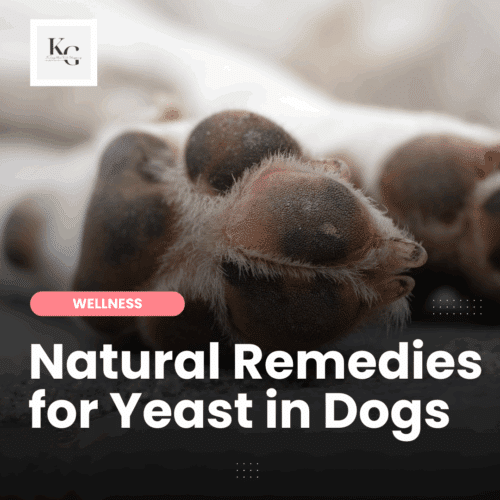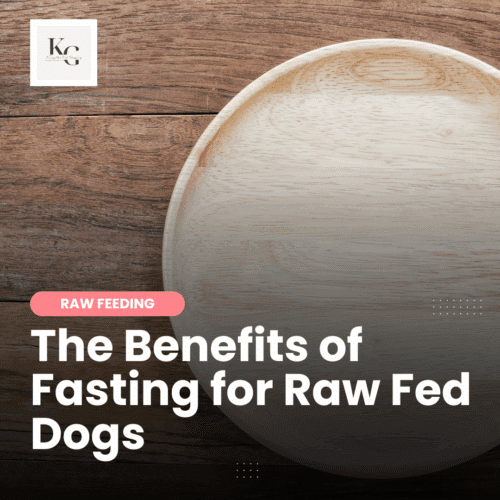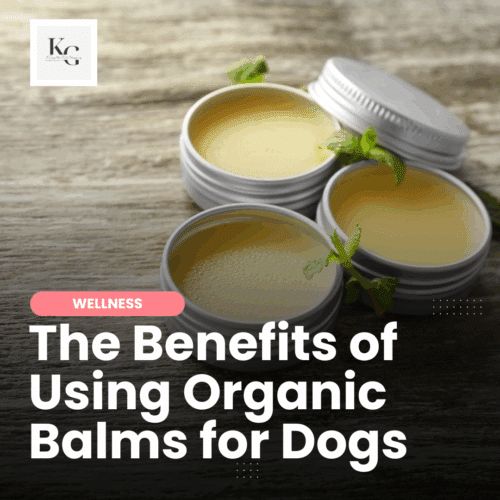Keep the Tail Wagging is supported by pet parents. I occasionally earn a commission (at no additional cost to you) when you click through an affiliate link to one of my favorite products. Thank you for your support. Read More
Yeast infections in dogs are more common than many pet parents realize. A yeast overgrowth may be to blame when your dog starts itching, chewing their paws, or giving off a strong, musty odor. Fortunately, there are homemade and natural ways to support your dog’s healing without immediately turning to harsh pharmaceuticals. In this article, we’ll explore what yeast is, why it happens, and how to treat it naturally from the outside in.
What Is Yeast?
Yeast is a fungus that naturally lives on a dog’s skin and gut. It’s part of the normal microbial community and is usually checked by the immune system and beneficial bacteria. However, when the internal or external environment becomes unbalanced—due to diet, immune suppression, or overuse of antibiotics—yeast can multiply and cause infection.
The most common type of yeast affecting dogs is Malassezia pachydermatis. It thrives in warm, moist environments, such as ears, armpits, groin, paws, and skin folds.
What Causes a Yeast Overgrowth?
Yeast infections are a symptom of an underlying imbalance. Here are some common root causes:
- High-starch or carbohydrate-rich diets (including kibble)
- Food intolerances or allergies
- Suppressed immune system
- Excessive bathing with harsh shampoos
- Long-term antibiotic or steroid use
- Moisture and poor hygiene (wet paws, unclean ears, etc.)
- Environmental allergens
Foods & Activities That Contribute to Yeast Overgrowth
Understanding what fuels yeast is key to preventing future flare-ups. Yeast thrives on sugar and starches, so diets high in carbs can lead to chronic issues.
Common Triggers:
- Kibble: Even grain-free kibble often contains starchy ingredients like potatoes, peas, and legumes.
- Treats made with wheat, corn, rice, or oats
- Fruits with high sugar content (in excess)
- Overbathing or using shampoos with synthetic fragrances
- Lack of fresh air, sun, or exercise (especially in humid areas)
Homemade Topical Remedies for Yeast Infections
Once you’ve identified and removed the source, it’s time to soothe and support the skin. These natural treatments help restore the skin barrier, reduce itchiness, and combat yeast without disrupting healthy bacteria.
1. Apple Cider Vinegar (ACV) Rinse
Why it works: ACV restores skin pH and has antifungal properties.
- Recipe: Mix 1 part raw, unfiltered ACV with 1 part filtered water.
- Use: Spray onto affected areas (avoid open wounds), or use as a rinse after bathing. Let it air dry.
- Frequency: 1–2 times daily.
Do not use on raw, broken, or very irritated skin—it will sting.
2. Coconut Oil
Why it works: Coconut oil contains lauric acid, a natural antifungal and antimicrobial compound.
- How to use: Gently warm in your hands and massage into affected areas.
- Optional: Infuse with dried calendula or chamomile for added skin-soothing benefits.
- Frequency: Daily or as needed.
Choose unrefined (virgin), cold-pressed, organic coconut oil; I recommend CocoTherapy, the only brand I use.
3. Green Tea or Herbal Rinses
Why it works: Green tea is rich in antioxidants and reduces inflammation; chamomile and calendula are calming and antimicrobial.
- Recipe: Steep 2–3 green tea bags (or 1 Tbsp dried herb) in 2 cups of boiling water. Cool completely.
- Use: Pour over the dog’s skin after a bath or use as a paw soak.
- Frequency: 2–3 times per week.
Although tempting, avoid cheap tea products at the grocery store. Instead, look for organic green or herbal tea products that don't have unnecessary ingredients.
4. Food-Grade Bentonite Clay Paste
Why it works: Bentonite clay binds to toxins, draws out moisture, and soothes irritated skin.
- Recipe: Mix bentonite clay with filtered water to form a paste.
- Use: Apply to infected areas and allow to dry before rinsing off.
- Frequency: Once daily until symptoms improve.
This treatment shouldn't be used indefinitely because the clay is drying and can cause issues if used over an extended period.
5. Yogurt or Kefir Topical Probiotic Mask
Why it works: Live probiotics help crowd out yeast and rebalance the skin microbiome.
- Recipe: Use plain, unsweetened yogurt or kefir (goat’s milk preferred).
- Use: Apply a thin layer to the affected skin, let it sit for 10–15 minutes, and then rinse gently.
- Frequency: 2–3 times weekly.
Avoid if your dog has dairy sensitivities.
6. Aloe Vera Gel
Why it works: Aloe is cooling, healing, and helps relieve itching.
- Use: Apply a thin layer of pure aloe vera gel (from the plant or organic product) to irritated areas.
- Frequency: As needed for relief.
Use an organic aloe vera gel product to avoid unnecessary ingredients or toxins absorbed from the processing.
Natural Bathing Routine
Dogs with yeast overgrowth benefit from regular—but not excessive—baths.
DIY Anti-Yeast Bath:
- 1 cup of organic apple cider vinegar
- ½ cup of coconut oil (melted)
- 2 green tea bags (steeped in 2 cups of water)
- Optional: 1 drop lavender essential oil (only if safe and well-tolerated)
Add ingredients to warm bathwater and soak the dog for 10–15 minutes. Pat dry—don’t rinse.
Support Healing from the Inside Out
Topical remedies are helpful, but long-term healing happens from within. Support your dog’s gut and immune system to prevent recurrence.
Feed a Fresh, Low-Starch Diet:
Fresh food removes what feeds yeast and supports what fights it. Over time, this shift can restore balance to your dog’s skin, gut, and immune system, leading to fewer flare-ups and better overall health.
- Proteins: Grass-fed beef, pasture-raised chicken, turkey, venison
- Veggies: Leafy greens, zucchini, broccoli (lightly steamed or pureed)
- Supplements: Omega-3s (from sardines or fish oil), digestive enzymes, probiotics
Switching to raw doesn't resolve all yeast issues. While it does help improve a dog's health, additional treatments may be necessary depending on the cause of the yeast. For instance, you may need to do at-home natural treatments periodically.
Add Gut-Boosting Foods:
- Raw goat’s milk or kefir (after healing period)
- Bone broth
- Fermented veggies (in moderation)
Prevention Tips
- Keep ears dry after baths or swimming
- Wipe paws after walks (especially in humid or polluted areas)
- Rotate proteins and avoid feeding too many sugary fruits
- Support immune health with herbs like turmeric, reishi, and astragalus
- Avoid antibiotics and steroids unless absolutely necessary
Are Fermented Foods Safe for Yeasty Dogs?
Fermented foods are often praised for their gut health benefits. When a dog is actively dealing with a topical yeast infection or systemic yeast overgrowth, fermented foods can sometimes make things worse instead of better—here’s why:
1. Fermented Foods Contain Yeast
Many fermented foods (like kefir, raw goat's milk, and fermented veggies) contain live yeast cultures and beneficial bacteria. While these yeasts are usually harmless or helpful in small amounts, a dog already struggling with a yeast imbalance may feed the problem, especially if the yeast strain is opportunistic.
2. Some Fermented Foods Contain Residual Sugars
Fermentation doesn’t always eliminate all natural sugars, especially in products like kefir, yogurt, or kombucha. These sugars can fuel pathogenic yeast, contributing to flare-ups, itching, and inflammation.
3. The Gut May Be Too Compromised to Handle It
Dogs with yeast overgrowth often have leaky gut or dysbiosis (an imbalance of gut flora). Introducing even beneficial microbes from fermented foods may trigger die-off reactions or worsen inflammation if their system is not yet ready for the influx of microbes.
4. Histamine Sensitivity
Fermented foods are high in histamines, which can aggravate skin conditions, inflammation, and itching in sensitive dogs, making yeast symptoms feel worse even if the underlying cause is being addressed.
So, What’s the Solution?
- Avoid fermented foods during active yeast flare-ups.
- Focus first on gut healing with low-starch, anti-yeast diets, gentle probiotics, and immune support.
- Once the yeast is under control, slowly reintroduce fermented foods one at a time to rebuild the microbiome.
Foods for Dogs with Yeast Issues
| Category | SAFE / SUPPORTIVE FOODS | AVOID / MAY TRIGGER YEAST |
|---|---|---|
| Proteins | Grass-fed beef, pasture-raised poultry, venison, rabbit, lamb, sardines | Highly processed meats, proteins with additives or preservatives |
| Vegetables | Leafy greens, zucchini, broccoli, cucumber, celery, green beans (lightly steamed or pureed) | Sweet potatoes, carrots, peas, corn, white potatoes (high in starch) |
| Fruits | Blueberries (in moderation), raspberries, cranberries (unsweetened) | Bananas, apples, mangoes, watermelon, pineapple (high sugar) |
| Fermented Foods | After healing: plain kefir, raw goat’s milk, fermented veggies (small amounts) | During flare-up: any fermented foods (due to live yeast and histamines) |
| Oils / Fats | Coconut oil (antifungal), fish oil (omega-3s), hemp seed oil | Corn oil, vegetable oil, seed oils high in omega-6s |
| Treats | Dehydrated single-ingredient meats, Real Dog Box chews, organ meats | Store-bought biscuits, dental chews, treats with flour, sugar, starches |
| Supplements | Digestive enzymes, soil-based probiotics, slippery elm, turmeric, astragalus | Sugary multivitamins, flavored supplements with fillers or rice flour |
| Grains / Starches | None recommended during yeast flare | Rice, oats, barley, wheat, quinoa (convert to sugar and feed yeast) |
| Dairy | Raw goat milk (after healing), plain unsweetened Greek yogurt (if tolerated) | Regular cow’s milk, cheese, processed yogurt, dairy with added sugar |
When to See a Vet
Consult a holistic or integrative veterinarian if symptoms worsen, spread, or cause extreme discomfort. Persistent yeast infections may signal an underlying condition such as hypothyroidism, Cushing’s disease, or autoimmune imbalance.
Do NOT seek advice in a social media group. While members may have had similar experiences and some identify as canine nutritionists and canine health coaches, they do not have the medical training required to address this issue, which can become serious. However, a holistic or integrative veterinarian can assess your dog's diet, lifestyle, and other symptoms to help get your dog on a healing path.
My Experience with Yeasty Dogs
Topical yeast infections are frustrating but manageable with a natural, whole-body approach. Combining homemade remedies with dietary changes and immune support can help your dog feel more comfortable, smell better, and heal from the inside out, without unnecessary medications. I've had two dogs with yeast issues: one with ears and skin (tummy/armpit area), the other with paws.
Dog #1: Yeasty Ears – I did this for seven days and never had a recurrence.
- 50/50 brewed green tea and water in a travel-sized water bottle.
- Mist ears twice daily and let sit 10 to 15 minutes.
- Wipe ears out gently with a soft tissue.
- Massage a dime-sized amount of coconut oil into the ear.
I did the same on my dog's tummy and armpit areas, with slightly more coconut oil. I did this at night to allow the coconut oil to sit on the skin overnight.
Dog #2: Paws – the areas between his toes were itchy and red.
- 50/50 brewed green tea and water in a travel-sized water bottle (or 33/33/34 with apple cider vinegar if the skin isn't broken)
- Mist paw pads each evening, twice daily if the dog will be in the house for the day.
- Massage a small amount of coconut oil onto the paws and between the toes.
I do this before we turn in for the night to keep the coconut oil on the paws.





